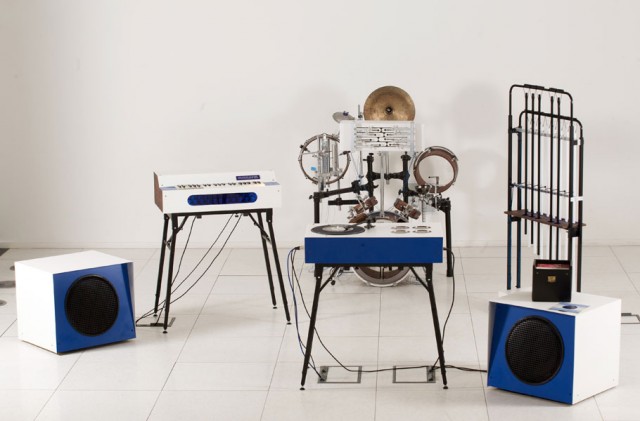One perhaps unexpected impact of technology has been to change the way we think about ourselves and our experience. Recording equipment – from photography to phonograph – has given us a new sense that memory itself might be fixed, unchanging, an accurate record of an unmoving truth.
Except, of course, neither the recorded object nor the thing it is recording ever quite seems to work out that way. (Ask your local theoretical physicist, or for a more localized, humanized, sociological view, any loved one.)
UNRAVEL is an installation that uses just those sorts of technologies to construct a narrative, and push and tug at that narrative. And if you don’t like it, well, that’ll impact the video, too. (Just complain via Twitter, and you’ll make the narrator “increasingly insecure.” As a blogger, I can relate.)
Combining record playback, a robotic band contributing incidental music, and a set of interactive dials, the installation recounts a story with mechanically-reproduced soundtrack, as the audience adjusts what happens. It’s all clear in the extended video:
More information:
UNRAVEL opens to the public on 20 April – 7 May as part of Glasgow International Festival of Visual Art at Arch 24/ SWG3.
UNRAVEL is a collection of devices making up a gallery-based, reactive sound installation, through which the audience will attempt to unravel the truth about The Narrator’s life by playing records from his collection.
When we tell the story of a memory, how much of it is true and how much is shaped by who we are talking to? Once we’ve told the story many times, how do we even know what is true any more – what is constructed and what actually happened?
The installation is the work of Edinburgh based arts collective / experimental pop band FOUND, whose members include Ziggy Campbell, Simon Kirby and Tommy Perman and Glasgow-based author and musician, Aidan Moffat best known as one half of the band Arab Strap. FOUND and Aidan Moffat are signed to Glasgow record label Chemikal Underground.
At the heart of the installation is a vinyl record player and ten 7” records of familiar singles from pop music’s heyday. Visitors to the gallery are encouraged to select a record from the collection to be played. As soon as they drop the needle on to the record the installation springs to life. The vinyl controls a series of acoustic, self-playing musical instruments positioned throughout the gallery which soundtrack the story as the narrator recounts a memory he associates with that record. Each 7” record represents a different memory, but unlike conventional vinyl recordings they sound different each time they are played.
Just as a real narrator alters the way they tell a story depending on their mood, audience and context, the memories embodied in the installation will distort, evolve and warp depending on external influences: the time of day, the size of #UNRAVEL’s audience, the local weather, and what people are writing about the installation on twitter from moment to moment.
A year in the making, #UNRAVEL is the first collaboration between FOUND and Aidan Moffat and represents a major new body of work for both. The project required Aidan to write 10 short stories with multiple variations of each, to be soundtracked by a total of 160 new musical compositions by FOUND.
With Investment from Creative Scotland’s Vital Spark programme and New Media Scotland‘s Alt-w Fund with the support of the Centre for Design Informatics, Glasgow International Festival of Visual Art, SWG3 and the University of Edinburgh.
Funny side note: I recall some evenings out drinking with Scottish people that also questioned the boundaries of what is real and not real and the imperfection of memory, though more in a performative, real-time sense than in an interactive installation. (I was a willing and active participant, so I’ll not hold this experience against the fine countrymen and women of Scotland. Indeed, I hope to toast with these chaps next time I’m in Glasgow. I, of course, do not condone such behavior, and you will find that by contrast, this particular interactive installation has no ill health effects that I know of.)
For something completely different, here’s a beautiful set of instrument robotic solos incorporating acoustic instruments, plants, and bamboo:
A composition for plants, yangqin, bamboo robot and robotic chimes, Three Pieces is designed as a collaboration between robots, traditional instruments, and living things, housed in Victorian Palm House of the Royal Botanic Garden in Edinburgh. A traditional Chinese dulcimer is played by a robot with many bamboo fingers while the surrounding foliage hides an ensemble of robotic chimes. Despite being separate individuals, the robots communicate and perform together. The robot performers are conducted by all the living things in the Palm House. The moisture content of the soil changes slowly as the plants absorb water, while on a much faster timescale, the temperature changes in the building as animals, including humans, move about. The installation detects this living presence in the Palm House and the music changes accordingly. The robots react to humans, but their mood alters with the plants. For more info visit… foundcollective.com
Previously:
Plant-Reactive Robots Play Bamboo, Chinese Instruments at Royal Botanic Garden, Scotland
Reconceived Acoustic Music on an Interactive Table: Etiquette in Edinburgh
